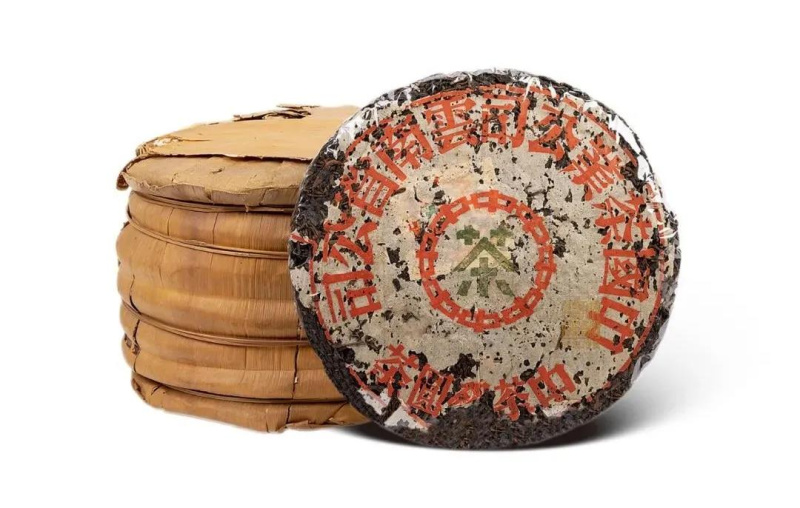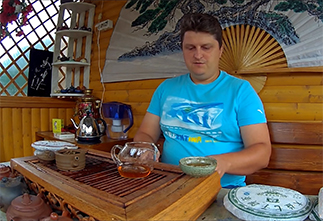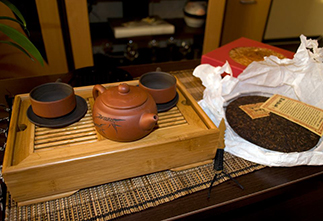The aroma when warmed by breathing is quite restrained - you need to make the first infusion to get to know this puer.
The steamed tea leaf has an extremely noble, balanced and pure aroma. Classic puer notes are intertwined here: nuts, dry wood, a little prune and sweet pastry.
The taste of brewed tea is pure, balanced, slightly sweet, aristocratic and subtle. You want to drink this puer slowly, taking each note into account. Nutty-woody nuances, caramel sweetness and the taste of cold spring water, which in childhood was drunk slowly, but with great pleasure.
The key to this puer is its aftertaste. It is very bright, sweet, like a croissant with chocolate and fudge, it fills the entire mouth with its thickness, and reminds you of itself for a long time.
This pu-erh acts very gently, carefully balances, sobers and calms.
When brewing, you can add a little more tea leaves, this will make the infusion more velvety.
Approximately 10-12 grams per 100 ml. The tea is best revealed in a teapot made of Yixing clay or gaiwan. The charming color of the infusion immediately catches the eye - dark burgundy with a red tint, very transparent!
It is priceless to start the morning with this puer, aged, soft and velvety, it is very easy to drink.
|
Name in Chinese
|
勐海七子饼茶 |
|
Pinyin
|
měnghǎi Qīzi bǐng chá |
|
Translation
|
A pack of seven Menghai tea cakes |
|
Country
|
China |
|
District
|
Xishuangbanna Dai Autonomous Prefecture |
|
Provinces
|
Yunnan (云南) |
|
Manufacturer
|
Тяньдижэнь (Небо, Земля, Человек) |
|
Raw material production date
|
2008 |
|
Year of pressing
|
2008 |
|
Recipe
|
726A |
|
Pressing form
|
Bing Cha (Cake Tea) |
- Комментарии
- Вконтакте
Pu-erh is one of the most unique types of tea, which only gets better with age. Many people, when they first encounter this tea, wondered: why is pu-erh more often found in pressed form (cakes, bricks, tochas), and not in loose form? The reasons for this are related to both history and the practical aspects of storing and fermenting tea. Despite modern technologies that allow the production of loose pu-erh, the shape of pressed cakes remains unchanged. And pu-erh is more often found on sale in pressed form, for example, in the form of cakes or bricks, and loose pu-erh is less common. We will talk about the reasons for pressing pu-erh into cakes in this article.
Puer is a unique Chinese tea that is distinguished by its depth of taste, complexity of aromas and versatility of aftertaste. Its taste characteristics are formed under the influence of many factors, from growing conditions to the brewing method. Let's look at the main ones.
The question often arises: how to brew puerh correctly? Sometimes the phrase "to get high" is added to it. Moreover, everyone has their own understanding of this phrase. Some mean vigor, and some - intoxication. So how to brew puerh tea correctly? Let's consider several options.
Traveling through the tea mountains, we found ourselves in another land of blue roofs - the village of Zhongcai, which is located in the Menghai district of Yunnan province. According to tradition, we were shown another local tea tree, which, according to the Chinese, is at least a million years old :) The village is very authentic, not designed for tourists, there are many wild pu-erhs there and, of course, we were warmly received. They treated us to local cuisine and tea. We also asked the residents about the prices of tea and how they have changed in recent years.
The tea ceremony occupies a special place in the centuries-old Eastern tradition. And although the essence of this phenomenon remains constant, the nature and external manifestations of the tea ceremony in different nations have their own national characteristics. In each Chinese province, the tea ceremony and the tea used in it are varied: for example, residents of the southern provinces prefer green tea, and residents of the northern provinces - red tea, in Fujian province they more often use Oolong tea, and in Yunnan province Puer tea is widely known.

























































































